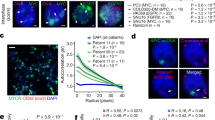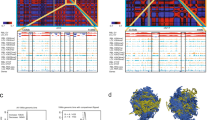Abstract
The HuBlym-1 gene has been isolated from Burkitt's lymphoma DNA on the basis of its reported ability to produce foci of cells when NIH 3T3 cells are transfected with it1,2. The sequence of HuBlym-1 has been reported1 but it has not been established whether the sequence of the transforming gene differs from that of the gene in normal tissue, as might be expected from the common observation of mutational activation of proto-oncogenes into oncogenes. I report here that there are no differences between the sequences of three recombinant DNA clones that were isolated from Burkitt's cell lines and that cross-hybridize to HuBlym-1 but do not induce foci when transfected into NIH 3T3 cells, and the reported sequence of Burkitt's lymphoma Blym3. Also there is no obvious or consistent increase in the transcription of the HuBlym-1 gene in Burkitt's lymphoma cell lines of the type that might otherwise have accounted for its transforming activity even in the absence of a mutation. How the HuBlym-1 gene is activated therefore remains a mystery.
This is a preview of subscription content, access via your institution
Access options
Subscribe to this journal
Receive 51 print issues and online access
$199.00 per year
only $3.90 per issue
Buy this article
- Purchase on Springer Link
- Instant access to full article PDF
Prices may be subject to local taxes which are calculated during checkout
Similar content being viewed by others
References
Graham, F. V. & van der Eb, A. J. Virology 52, 456–467 (1973).
Diamond, A., Cooper, G. N., Ritz, J. & Lane, M. A. Nature 305, 112–116 (1983).
Diamond, A., Devine, J. M. & Cooper, G. M. Science 225, 516–519 (1984).
Lane, M. A., Sainten, A. & Cooper, G. M. Cell 28, 873–880 (1982).
Taparowsky, E. et al. Nature 300, 762–765 (1982).
Capon, D. J., Chen, E. Y., Levinson, A. D., Seeburg, P. H. & Goeddel, D. V. Nature 302, 33–37 (1983).
De Feo, D. et al. Proc. natn. Acad. Sci. U.S.A. 78, 3328–3332 (1981).
Chang, E. H., Furth, M. E., Scolnick, E. H. & Lowry, D. R. Nature 297, 479–483 (1982).
Goubin, G., Goldman, D. S., Luce, J., Neiman, P. E. & Cooper, G. M. Nature 302, 114–119 (1982).
Sanger, F., Nicklen, S. & Goulson, A. K. Proc. natn. Acad. Sci. U.S.A. 74, 5463–5467 (1977).
Maxam, A. M. & Gilbert, W. Meth. Enzym. 65, 499–560 (1980).
Magrath, I. T. et al. J. natn. Cancer Inst. 64, 465–470 (1980).
Epstein, M. A. et al. J. natn. Cancer Inst. 37, 547–559 (1966).
Epstein, M. A. & Achong, B. G. (eds) in The Epstein Barr Virus, 322–337 (Springer, New York, 1979).
Nichols, W. W. et al. Science 196, 60–63 (1977).
Author information
Authors and Affiliations
Rights and permissions
About this article
Cite this article
Devine, J. Mechanism of activation of HuBlym-1 gene unresolved. Nature 321, 437–438 (1986). https://doi.org/10.1038/321437a0
Received:
Accepted:
Issue Date:
DOI: https://doi.org/10.1038/321437a0
This article is cited by
-
Blym clone could be contaminant
Nature (1986)
Comments
By submitting a comment you agree to abide by our Terms and Community Guidelines. If you find something abusive or that does not comply with our terms or guidelines please flag it as inappropriate.



